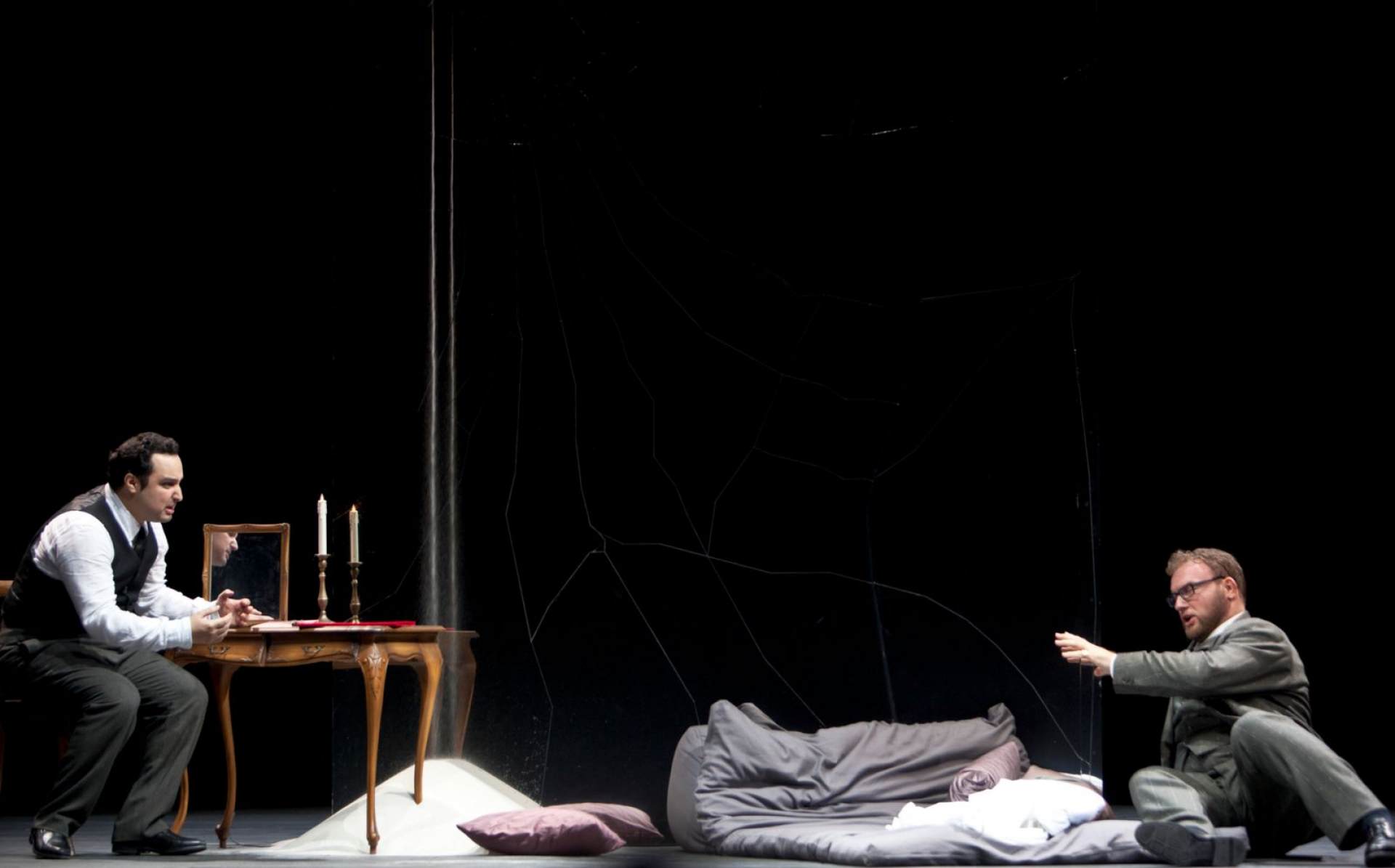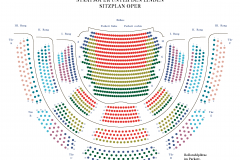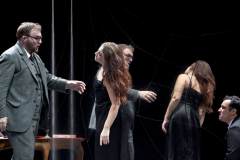La traviata
July 2025 | ||||||
|---|---|---|---|---|---|---|
Mo | Tu | We | Th | Fr | Sa | Su |
MELODRAMMA IN THREE ACTS (1853)
MUSIC BY Giuseppe Verdi
TEXT BY Francesco Maria Piave after Alexandre Dumas d.J.
Violetta Valéry is a noble courtesan in Paris who has »strayed from the path of virtue« and leads a life that oscillates between splendour and misery. For her everything is a game – even love – until Alfredo Germont awakens true feelings in her. But this rare happiness only lasts fleetingly for Violetta, who suffers from tuberculosis, and who is first publicly humiliated before passing away.
Only once did Giuseppe Verdi turn his attention to a contemporary subject, Alexandre Dumas the Younger’s »La dame aux camélias«. As a novel and a play, Dumas based his story on true events. Verdi composed a score of great intensity that conveys a wide range of emotions: joy and exuberance, sorrow and despair. The audience is pulled into the plot and feels directly affected by Violetta’s fate. As the last work of the »trilogia populare«, »La Traviata«, which premiered in 1853 and was first shown at Unter den Linden in 1860, quickly quashed initial scepticism and became a successful opera on an international scale. Dieter Dorn’s production portrays Violetta as a woman condemned to death from the very beginning, but who rebels against her fate. In the end, she fades away, almost ethereally.
PLOT
FIRST TABLEAU
Violetta Valéry is ill. Musically speaking, the story is told beginning with her death. It is with her death that the opera begins and ends, the dream of an impossible love. She has decided to hold a party as medicine against the consumption she is suffering from: in the tumult of the crowd, in delirium, in joint drinking she wants to surrender herself to pleasure. Gastone, Vicomte de Letorières, introduces to her a new guest, Alfredo Germont, who has been her admirer for a year and offers her his love and a restful life. Violetta is forced to decide, between Baron Douphol, who has been paying her for a year, or Alfredo, whom she loves like no other before. In the early morning after her guests have departed, Violetta tries to decide what she wants: a serious love, or a life that is entirely dedicated to pleasure. She decides for Alfredo.
SECOND TABLEAU
Violetta and Alfredo have now lived for three months in the country. They are happy, but their money is running out. Violetta, assisted by her servant Annina, is occupied with selling all her possessions, since she no longer earns any money. Alfredo praises his luck at gambling, but in his carelessness doesn’t think about how to finance it. When Annina tells him that Violetta is just about to sell everything, he travels to Paris to find a different solution. In the meantime, his father Giorgio Germont visits Violetta. He accuses her of wasting the family’s money and destroying their reputation. Violetta at first denies this vehemently Although Germont knows his error, he argues with all means and tricks against Violetta’s relationship with Alfredo. He asks her to leave Alfredo, to avoid preventing his daughter’s planned favorable marriage. Violetta is forced to accept that the “better circles” do not forgive, that her new life is not accepted. She then decides for a radical break. She will pretend to return to her old life. An invitation to a party hosted by Flora Bervoix, her friend and competitor, that she just received, offers her the opportunity to meet with the baron. She writes a goodbye letter for Alfredo, which he receives after her departure.
THIRD TABLEAU
Flora’s party: Violetta is planning to attend. It is rumored that she and Alfredo are no longer a couple. The party begins with the appearance of “the gypsy women”, who read the palms of Flora Bervoix and her lover, Marquis d’Obigny, revealing his constant infidelity. They are followed by a group of bullfighters, led by Gastone. They tell the story of the brave Piquillo, who has to kill five bulls in order to win over his love. But the party has little interest in bravery; they are satisfied with enjoying pleasure and risky gambling. Violetta appears with the Baron. Alfredo, who has come alone, wins his gambling matches, including those against the Baron. While all go off to dine, Violetta warns Alfredo of the Baron. Alfredo tries to force her to leave with him. But she refuses, claiming to love only the Baron. Alfredo then insults Violetta publicly, by paying her the money he won in the game. His father, who arrives in just that moment, condemns this behavior, as does the Baron, who challenges him to a duel.
FOURTH TABLEAU
It is carnival in Paris. Violetta is alone with Annina, when the doctor arrives. He comforts Violetta, but tells Annina that death is immanent. A letter from Germont reveals to Violetta that the duel has taken place. The Baron has been wounded, while Alfredo is on the run. His father told him the truth of Violetta’s unfailing love. Violetta sways between hope and a certainty of death. Once again, the loud public erupts onto the scene, this time a masked bacchanalian chorus. Annina announces the arrival of Alfredo. The couple outdoes each other in mutual declarations of love. Violetta wants to go out, but she is too weak. They mourn the impossibility of their love. Giorgio Germont, who has now arrived, also joins in the mourning. Violetta is animated once more by an “unusual force,” but then dies with the words: “Oh joy…”, “Oh gio- - -ja.”
Program and cast
Duration: approx. 2:40 hrs including one interval after act one
Language: In Italian language with English and German surtitles
Recommended age: 12 years and older
CAST
MUSICAL DIRECTOR: Jérémie Rhorer
DIRECTOR: Dieter Dorn
DIRECTOR ASSISTANCE: Christiane Zaunmair
SET DESIGN: Joanna Piestrzyńska
COSTUMES: Moidele Bickel
COSTUMES ASSISTANCE: Dorothée Uhrmacher
LIGHT: Tobias Löffler
CHOREOGRAPHY: Martin Gruber
VIOLETTA VALÉRY: Jeanine De Bique
FLORA BERVOIX: Natalia Skrycka
ANNINA: Katharina Kammerloher
ALFREDO GERMONT: Bogdan Volkov
GIORGIO GERMONT: George Petean
GASTONE: Gonzalo Quinchahual
BARON DOUPHOL: Jaka Mihelač
MARQUIS D'OBIGNY: Taehan Kim
DOCTOR GRENVIL: David Oštrek
STAATSOPERNCHOR
STAATSKAPELLE BERLIN
State Opera Unter den Linden
Staatsoper Unter den Linden is one of Berlin's most prestigious opera houses, with a rich history and significant cultural impact.
History:
The Staatsoper Unter den Linden was originally built between 1741 and 1743, under the direction of architect Georg Wenzeslaus von Knobelsdorff. It was commissioned by Frederick II of Prussia and was initially named the Königliche Oper (Royal Opera). The opera house has undergone several renovations and reconstructions, notably after World War II damage. It reopened in 1984, following a major renovation.
Construction:
The original design was characterized by its Baroque style, featuring an elegant façade and a grand entrance. The building was reconstructed in the 1950s and 1980s, maintaining its classical exterior while modernizing the interior. The façade features a classic portico with six Corinthian columns and a prominent central pediment.
Interior:
The interior is known for its opulent and classical design. The auditorium is renowned for its acoustics and grandeur, with luxurious velvet seats and elaborate decorations. The stage and seating areas have been updated to meet modern performance standards while preserving historical aesthetics.
Concerts and Performances:
The Staatsoper Unter den Linden hosts a variety of performances, including operas, orchestral concerts, and ballet. It is home to the Staatskapelle Berlin, one of Germany's leading orchestras. The opera house is celebrated for its high-quality productions and its role in Berlin’s vibrant cultural scene.
JOURNEY
The Staatsoper Unter den Linden has completely barrier-free access due to its excellent public transport connections.
ADDRESS: Unter den Linden 7; 10117 Berlin
SUBURBAN RAILWAY
S+U Friedrichstraße (S1, S2, S5, S7, S25, S75)
SUBWAY
Hausvogteiplatz (U2)
Museumsinsel (U5)
Stadtmitte (U2, U6)
Unter den Linden (U5, U6)
BUS
Staatsoper (100, 245, 300)
Unter den Linden/Friedrichstraße (100, 147, 245, 300, N6)
PARKING
Q-PARK parking garage Unter den Linden/Staatsoper
Bebelplatz, 10117 Berlin
There are five electric charging stations in the parking garage. Further information can be found here.
The underground car park on Bebelplatz offers disabled parking spaces and direct access to the opera house. On entering the car park between 5.30pm and 11.30pm, the maximum parking fee is €7. To use this tariff, enter your parking ticket in one of the pay machines and the message »Theatertarif« will appear on the display. Please note that it is not possible to use the tariff if you enter the car park before 5.30pm. so it will not be shown on the display. TIP: If you pay the theatre tariff at the pay machine before the event, you can avoid unnecessary waiting after the show.

 EN
EN DE
DE IT
IT FR
FR ES
ES RU
RU JP
JP RO
RO
 Seating plan
Seating plan 

